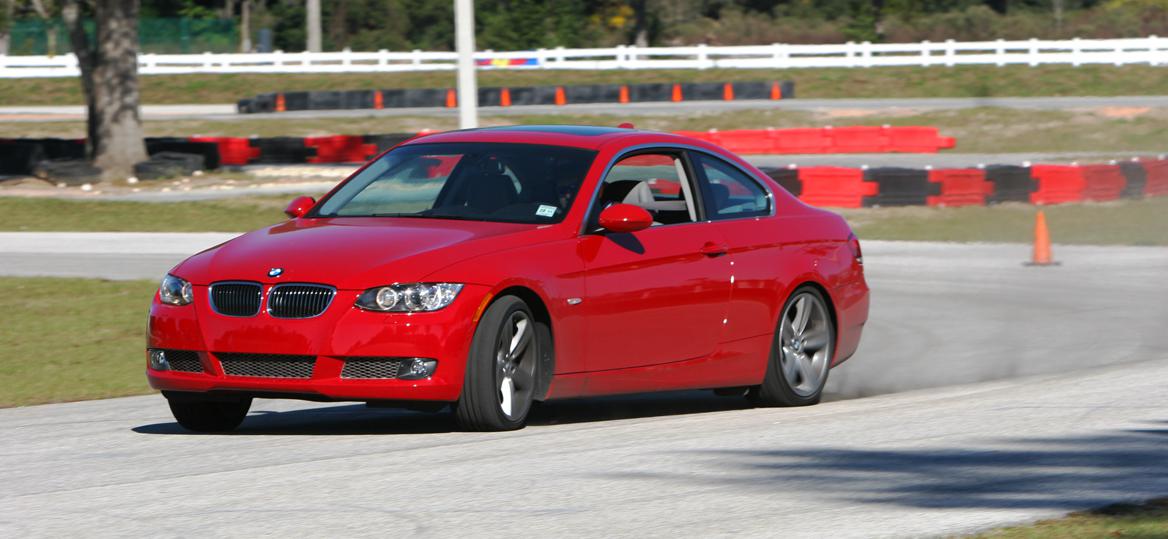These cars are capable of big power with a software upgrade, but to make the most of it, you need to put the power to more than one rear tire. A clutch-type limited slip is ideal for track use and my preference in a street car. But there are lots of options for limited-slip differentials, and you should consider one.
As these cars get older, coolant system service will help them stay on the road and avoid engine damage. Replace the plastic-tanked radiator before it breaks–something like our CSF all-aluminum unit will also help keep things cooler, which is critical for performance use. You should also swap out the coolant hoses, electric water pump and thermostat for new stock units.
These cars didn’t start with suspensions as crisp as an M3’s by design, and typical used-car mileage doesn’t help them any. A full complement of Powerflex urethane bushings will restore a 335i’s suspension and make it handle better than new–and even better than an M3. With 14 total suspension arms as well as soft spots in the subframe, these cars have plenty of opportunity for improvement. The good news is that you can start with the more critical locations first.
MEET OUR EXPERT:
Karl Hugh
Active Autowerke
Some of the most popular modifications we see are piggyback tunes and DME flashes. Of the two, the flash is definitely more professional: It can offer power delivery that’s 10 times smoother and super consistent. A piggyback tends to be steppy in boost delivery, so the resulting power acts the same. The DME flash also enhances many other areas, like the road speed governor and engine rev limiters. The piggyback can’t alter internal torque maps, so many owners opt to jack up the boost, which takes its toll on the turbochargers and causes them to kick the bucket earlier.
If you’re looking for a good bang-for-the-buck upgrade, the DME flash is a great place to start. Hands down, that is one of the most powerful mods for the price.
The drivetrain is very adequate, but if you start making lots more power with bigger turbos, you may want to upgrade the clutch or automatic transmission clutch plates.
If you’re going to start modifying and have to focus on one aspect first, it should be improving power. A nice coil-over suspension would be next.
The biggest problem with these cars is their high-pressure fuel pumps. It was a huge epidemic for a few years. The fuel injectors would go south, sometimes along with ignition coils. Some of the early DME cars had output transistor problems, too, causing misfires that couldn’t be fixed unless the DME was replaced or repaired. The early cars came with a Siemens MSD 80 DME, but BMW fixed the issue around March 2008 by switching to an MSD 81 DME.
Don’t over-speed the turbochargers by jacking the boost to get power. Do it right by using a good flash that optimizes the internal torque maps. We make much more reliable power by increasing the boost to 13-14 psi and upping the torque maps than by ramping the boost to 17 psi and over-speeding the turbochargers.
Replace the spark plugs at 20,000-25,000-mile intervals. If you don’t, the electrodes wear off and the gaps get too wide. The DME then tries to up the spark and ends up burning out the ignition coils and DME output transistors. Save yourself a lot of trouble with this cheap maintenance procedure.
Keep the air filters clean. Dirty filters will quickly wipe out the turbochargers.
Clean oil is another must. If you’re running big power, switch to a heavier-weight oil. A turbocharged car will love a thicker oil film, as the piston is being pushed harder on the power stroke.
If you plan on putting one of these cars on track, oil cooling is a must. The typical single large oil cooler doesn’t really cut it. Oil temps still get up to 260 degrees Fahrenheit, and you’ll want to keep it at no more than 240. We also modify the water pump cooling in the tune flash; we speed it up to help combat the extra heat generated from boosting the power.
Exhaust downpipes and a cat delete help to lower EGTs, which will help keep engine temps down as well.
If you’re shopping for a 335i, be on the lookout for engines that may be tired from poor blow-by and low compression. Turbochargers worn out from over-boosting are also of concern. Coked-up oil in the turbocharger is another red flag, whether it’s due to poor cooldown or dirty oil from prolonged oil change intervals.
Replacing turbochargers typically takes 8 to 10 hours, since you have to remove the entire subframe to gain access to them.
Leaky valve-cover gaskets can indicate a highly tuned N54 that has grown tired. If the valve cover is brittle and the motor checks out, then a new gasket is needed. But beware: This is a 6-hour job.
The N54 is typically a robust engine that can take a lot of abuse and make good power. Some have Vanos failures, but BMW looked after the early ones.





























